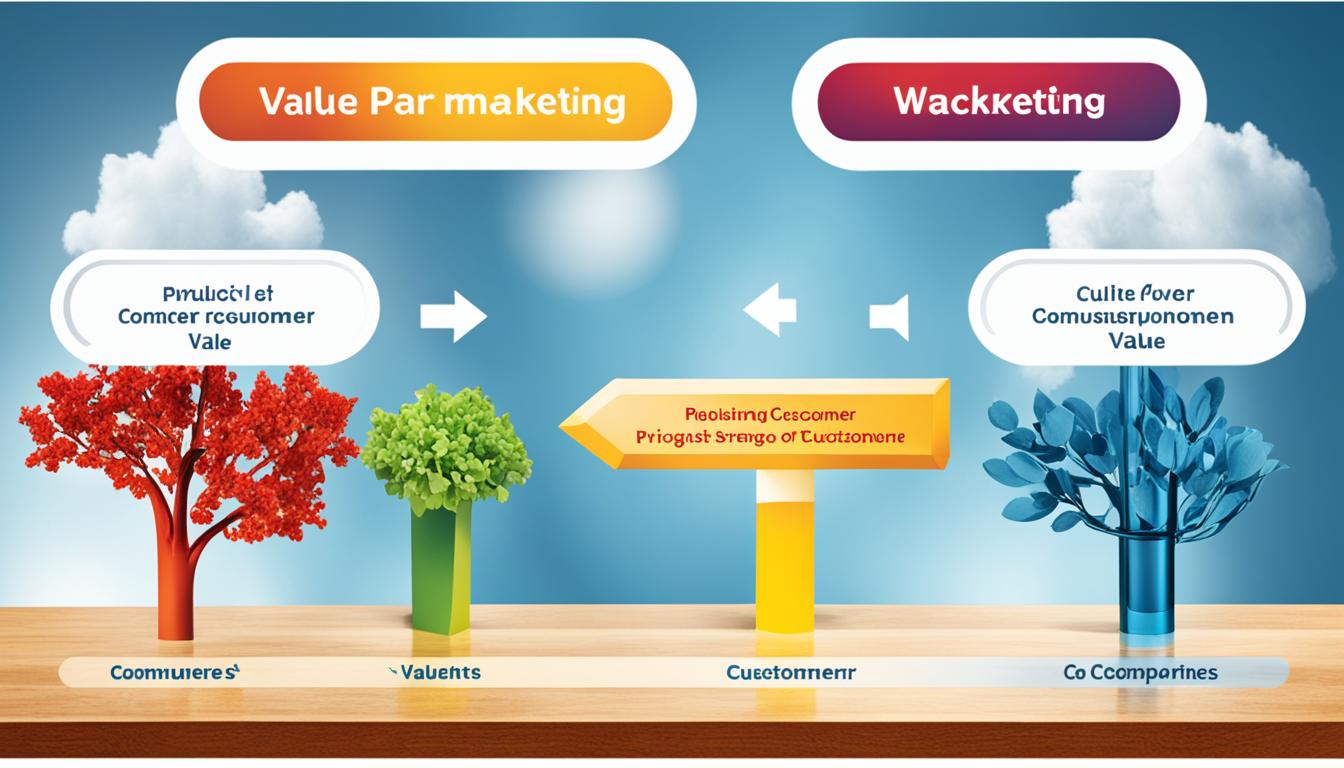In today’s competitive business landscape, marketing scalability has become a crucial factor for success. As companies strive to reach larger audiences and generate more revenue, they need strategies that can adapt and expand with their growing needs. In this article, we will explore the concept of marketing scalability, the importance of scalable marketing strategies, and how businesses can effectively scale their marketing efforts.
Key Takeaways:
- Marketing scalability is essential for businesses seeking growth and revenue generation.
- Scalable marketing strategies allow companies to maintain efficiency as sales volume increases.
- Technology, such as software automation, has made scaling more accessible for businesses.
- Effective scaling requires identifying the target market, defining the value proposition, choosing effective marketing channels, automating and delegating tasks, monitoring results, and continuously experimenting and innovating.
- By implementing scalable marketing solutions, businesses can reach more customers, increase brand awareness, and generate more revenue.
Steps to Begin Scaling Your Business
In order to scale your business effectively, it is essential to take the following steps:
Determine Market Need
Identify the market need for your product or service. Conduct thorough market research to understand the demand, competition, and potential customer base. This step is crucial to ensure that there is a sufficient market need to support your business growth.
Identify Potential Market Size
Assess the potential market size for your product or service. Calculate the total addressable market (TAM) by estimating the maximum revenue your business can generate if it captures 100% market share. This will help you understand the scale of the opportunity and make informed decisions about resource allocation and market positioning.
Create Systems for Business Growth
Develop systems and processes that can support your business growth. Establish streamlined operations, set clear objectives, and define key performance indicators (KPIs) to measure progress. Implement scalable technologies and automation tools to improve efficiency and productivity.
Consider Outsourcing Services
Identify tasks or services that can be outsourced to external providers. Outsourcing can help reduce operational costs, allow you to focus on core competencies, and access specialized expertise. Evaluate outsourcing options for non-core activities such as IT support, customer service, or digital marketing.
| Steps to Begin Scaling Your Business |
|---|
| Determine Market Need |
| Identify Potential Market Size |
| Create Systems for Business Growth |
| Consider Outsourcing Services |
By following these steps, you can lay the foundation for scaling your business successfully. Understanding the market need, potential market size, and implementing systems for growth are key elements to ensure sustainable expansion. Additionally, outsourcing services can help optimize resources and enhance operational efficiency, enabling you to focus on strategic initiatives that drive business growth.
Components of a Scalable Business Model
A scalable business model consists of three key components that enable organizations to efficiently manage growth and expand their operations. These components are:
1. Standardization
Standardization plays a crucial role in ensuring the efficient and timely completion of work, even when dealing with different partners or customers in various locations. By standardizing processes, procedures, and workflows, businesses can achieve consistency and streamline operations. This allows for easier scalability as the organization can replicate successful practices across different locations or with different partners. It also simplifies training and onboarding processes, reducing the time and effort required to bring new team members up to speed.
2. Consistent Management
Consistent management is essential for organizations looking to scale successfully. This involves ensuring seamless transitions and utilization of talent across different parts of the organization. With consistent management practices in place, companies can maintain operational efficiency and optimize resource allocation as the business grows. It also allows for effective communication and coordination between teams, reducing the chances of bottlenecks or duplicative efforts. Consistent management enables the organization to adapt to changing market conditions and scale up or down accordingly.
3. Use of Existing Assets
Leveraging existing assets is a key strategy for accelerating business growth and expansion. By using the resources and assets already available, organizations can minimize costs and maximize efficiency. For example, Airbnb’s business model leverages the existing properties of its members, allowing the company to rapidly scale its operations without the need for heavy upfront investments. This approach not only reduces capital requirements but also enables organizations to enter new markets quickly. By utilizing their existing assets effectively, companies can achieve scalable growth while maintaining financial stability.
| Component | Description |
|---|---|
| Standardization | Ensures efficient and consistent completion of work across different locations or partners |
| Consistent Management | Enables seamless transitions and effective utilization of talent across the organization |
| Use of Existing Assets | Maximizes efficiency and accelerates growth by leveraging available resources |
Examples of Scalable Businesses
During the pandemic, several companies demonstrated their scalability by adapting to the changing market conditions and successfully meeting the increased demand. Three notable examples of scalable businesses are Zoom, DoorDash, and Snowflake.
Zoom
Zoom, the popular video conferencing platform, experienced a tremendous surge in demand as remote work and virtual meetings became the norm. With its scalable infrastructure and virtual nature, Zoom was able to effectively handle the sudden increase in users and provide a seamless user experience. This scalability contributed to its significant revenue growth and established Zoom as one of the leading communication tools during the pandemic.
DoorDash
DoorDash and other food delivery services experienced a surge in demand during the pandemic as restaurants faced closures or restrictions on dine-in services. DoorDash’s ability to swiftly scale up its operations and connect customers with their favorite restaurants for convenient delivery showcased its scalability. By adapting to market conditions and meeting the increased demand, DoorDash played a crucial role in supporting both consumers and businesses during challenging times.
Snowflake
Snowflake, a cloud-based data platform, saw significant growth during the pandemic as businesses worldwide relied heavily on data analytics. Snowflake’s scalable cloud database technology enabled businesses to efficiently store, process, and analyze large volumes of data. The scalability of Snowflake’s platform proved essential in addressing the growing data needs of companies across industries, contributing to its success and growth as a leading player in the data analytics market.
In summary, Zoom, DoorDash, and Snowflake exemplify the characteristics of scalable businesses. Their ability to adapt, meet increased demand, and provide seamless experiences during the pandemic showcases the importance of scalability in today’s rapidly evolving business landscape.
Scalability as a Driver for Growth
A scalable business model serves as an engine for growth and has the potential to significantly impact a company’s valuation. By carefully considering market situations, addressing total addressable markets, implementing efficient systems and processes, and continuously adapting, businesses can unlock their growth potential.
Market Situations and Opportunities
To drive growth, businesses need to be aware of market situations and identify opportunities. This involves analyzing market trends, consumer behavior, and competitor activities. By understanding these factors, companies can identify untapped growth potential and make informed strategic decisions to capture it.
Total Addressable Market
Understanding the total addressable market (TAM) is critical for scalable growth. TAM represents the maximum revenue a business can generate by targeting its entire industry or market segment. By defining the TAM and developing strategies to penetrate different customer segments, businesses can align their growth plans with the market’s potential.
Efficient Systems and Processes
An efficient and scalable business relies on well-designed systems and processes that can handle increased workload without compromising quality or efficiency. Automation and technology play a crucial role in streamlining operations, reducing costs, and improving productivity. By implementing scalable systems, businesses can scale their operations without proportional increases in resources.
| Benefits of Scalable Systems | Impact on Growth |
|---|---|
| Increased operational efficiency | Enables businesses to handle higher demand and scale operations |
| Reduced costs | Allows businesses to allocate resources strategically and invest in growth initiatives |
| Improved customer experience | Enables businesses to consistently deliver high-quality products or services, leading to customer loyalty and positive word-of-mouth |
Continuous Adaptation
Scalability necessitates continuous adaptation to changing market dynamics, consumer preferences, and technological advancements. Businesses need to stay agile, monitor their performance, and adjust their strategies accordingly. This includes leveraging data analytics, conducting market research, and actively seeking feedback from customers to identify areas for improvement and seize new growth opportunities.
Unlocking Valuation and Investment Opportunities
A company’s scalability directly impacts its valuation and attractiveness to investors. A scalable business model demonstrates growth potential and the ability to generate substantial returns on investment. By focusing on scalability, businesses can position themselves as attractive investment opportunities and secure funding to accelerate growth.
By embracing scalability as a driver for growth, businesses can tap into their full potential and achieve sustainable success in today’s dynamic and competitive market.
What Is Scalability?
Scalability refers to an organization’s ability to perform well under increased operational demands or market conditions. It is a vital attribute for businesses operating in dynamic environments, ensuring they can adapt and thrive amidst changing circumstances.
In financial markets, scalability takes on a different meaning, focusing on a company’s capability to handle increased market demands. This involves efficiently managing higher transaction volumes, maintaining liquidity, and providing reliable services to meet the needs of a growing customer base.
In the corporate world, scalability encompasses the capacity of a company to maintain or improve its profit margins as sales volume increases. It involves optimizing resources, streamlining processes, and leveraging growth opportunities to achieve sustainable growth and profitability.
Scalability in Financial Markets
Financial markets are highly dynamic and subject to fluctuations driven by economic factors, investor sentiment, and global events. Scalability in financial markets refers to the ability of financial institutions, such as banks, investment firms, and exchanges, to handle increased trading volumes, process transactions efficiently, and provide seamless services to clients.
Financial institutions that can scale effectively are equipped with robust infrastructure, advanced technology systems, and efficient processes. They can adapt to changing market conditions, handle increased trading volumes, and accommodate a growing base of investors.
Scalability in the Corporate World
In the corporate world, scalability revolves around a company’s ability to expand operations and accommodate growth without compromising profitability. Scalable companies have streamlined processes, efficient resource allocation, and effective management systems in place.
Corporate scalability involves maintaining or improving profit margins despite increased sales volume and market demands. It requires optimizing operations, investing in technology and automation, and strategically allocating resources to support growth initiatives.
| Key Aspects | Financial Markets | Corporate World |
|---|---|---|
| Definition | Managing increased market demands and trading volumes | Maintaining or improving profit margins as sales volume increases |
| Focus | Efficient transaction processing, liquidity management | Optimizing operations, resource allocation |
| Requirements | Robust infrastructure, advanced technology systems | Streamlined processes, efficient resource allocation |
Understanding Scalability
Scalability is a crucial aspect of business growth and success. It allows organizations to adapt to an increased workload and take advantage of technology advancements. With scalability, businesses can expand their operations, acquire more customers, and enter new markets without being limited by their existing structure or available resources.
Advances in technology have revolutionized scalability, making it easier for businesses to achieve their growth objectives. With access to innovative tools and platforms, organizations can streamline their operations, automate processes, and efficiently scale up their operations.
Scalability is often associated with the concept of economies of scale, where increased production leads to reduced costs and increased profitability. By scaling their operations, businesses can optimize their resources and achieve higher levels of efficiency.
Furthermore, scalability enables businesses to adapt to changing market conditions and consumer demands. With the ability to quickly adjust their operations, companies can seize opportunities and stay ahead of their competitors.
The Relationship Between Scalability and Technology Advancements
In recent years, technology advancements have played a significant role in enhancing scalability. The emergence of cloud computing, data analytics, and artificial intelligence has provided businesses with powerful tools to scale their operations effectively.
Cloud computing has revolutionized scalability by offering flexible and scalable infrastructure resources. With cloud-based solutions, businesses can easily scale their operations up or down, depending on their needs. This flexibility allows organizations to respond to market demands quickly and efficiently.
Data analytics has also played a crucial role in supporting scalability. By leveraging data-driven insights, businesses can make informed decisions and identify opportunities for growth. Analytics can help organizations identify areas for improvement, optimize processes, and allocate resources effectively.
Lastly, artificial intelligence (AI) has the potential to transform scalability by automating repetitive tasks and optimizing business processes. AI-powered solutions can enhance efficiency, reduce costs, and enable organizations to focus on innovation and strategic initiatives.
By embracing scalability and leveraging technology advancements, businesses can unlock their growth potential and achieve sustainable success in today’s dynamic market.
The Benefits of Scalability
Scalability offers numerous benefits to businesses that aim to grow and thrive in a competitive environment:
- Increased Efficiency: Scalability allows businesses to optimize their resources and operations, resulting in improved efficiency.
- Cost Savings: By leveraging economies of scale, businesses can reduce costs and achieve higher profitability.
- Flexibility and Adaptability: Scalability enables organizations to quickly respond to changes in market conditions and consumer demands.
- Competitive Advantage: Scalable businesses are better positioned to seize opportunities and outperform their competitors.
- Enhanced Innovation: With scalable operations, businesses can free up resources and focus on innovation and strategic initiatives.
Scalability Case Study: Zoom
To illustrate the power of scalability, let’s take a look at the case of Zoom. During the COVID-19 pandemic, the demand for remote communication solutions skyrocketed. Zoom, with its scalable infrastructure and user-friendly platform, quickly adapted to the increased workload and experienced exponential growth.
While other video conferencing platforms struggled to handle the surge in users, Zoom was able to accommodate millions of new users seamlessly. This scalability allowed Zoom to become a household name and generate substantial revenue during the pandemic.
| Zoom’s Scalability Success | Data |
|---|---|
| Revenue Growth | $2.65 billion in 2020, a 326% increase from the previous year |
| User Base | Over 300 million daily meeting participants |
| Market Value | Approximately $100 billion as of 2021 |
Zoom’s ability to scale in response to increased demand showcases the importance of scalability in achieving business success.
What Distinguishes a Scalable Company
A scalable company sets itself apart by prioritizing efficient operations, consistent branding, and effective measurement and management. These key elements contribute to the company’s ability to adapt and grow without compromising quality or brand value. Let’s explore each aspect in more detail:
Efficient Operation
Efficient operation is the backbone of a scalable company. It involves optimizing processes and workflows to ensure smooth and streamlined operations, allowing the company to handle increased workload and scale up when needed. By implementing efficient operational strategies, such as automation and outsourcing, companies can maintain productivity, deliver results, and meet customer demands.
Consistent Brand Messaging
Consistent brand messaging is essential for a scalable company. It involves conveying a clear and uniform message across all marketing channels and touchpoints to establish brand recognition and trust. Consistency in brand messaging helps create a cohesive brand identity, resonates with target audiences, and builds brand loyalty. It ensures that customers receive a consistent experience regardless of where or how they interact with the brand.
Effective Measurement and Management
Effective measurement and management are vital for scaling businesses. By implementing robust measurement and tracking systems, companies can gather valuable insights and data to assess their performance, identify areas for improvement, and make informed decisions. Measurement allows businesses to monitor key performance indicators (KPIs) and evaluate the effectiveness of their strategies, ensuring that resources are optimized and efforts are aligned with business goals. Effective management ensures proper allocation of resources, efficient collaboration, and timely decision-making, facilitating the scalability of the company.
By focusing on efficient operation, consistent brand messaging, and effective measurement and management, scalable companies can position themselves for growth and success. These strategic elements foster adaptability, ensure customer satisfaction, and create a strong foundation for sustainable growth.
What Does “Scale” Mean in Business?
In the world of business, the term “scale” refers to achieving continuous growth and expanding operations to meet increased demand while maintaining profitability. A scalable business is one where the revenue generated surpasses the associated costs, allowing for sustainable expansion and business growth.
When a business scales, it means that it has successfully increased its operations, production, and sales volume, resulting in higher revenue. The goal of scaling is to achieve a level of growth that outpaces costs, leading to increased profitability and long-term success.
Scaling a business involves strategic planning and the implementation of effective systems and processes to support the growth. This may include expanding production capabilities, increasing marketing efforts, hiring additional staff, and optimizing operational efficiency.
Image:
One key aspect of scaling a business is ensuring that the revenue generated consistently exceeds the costs associated with the expansion. This ensures that the business remains financially stable and can continue to invest in growth opportunities.
Benefits of Scaling a Business
Scaling a business offers several benefits, including:
- Increased revenue and profitability
- Expanded market reach
- Enhanced brand recognition and reputation
- Improved operational efficiency
- Access to new markets and customers
By effectively scaling their operations, businesses can position themselves for long-term success and capitalize on growth opportunities.
Key Considerations for Scaling a Business
While scaling a business can lead to significant growth and success, it is important to consider certain factors:
- Market demand: Assessing the market need and potential demand for products or services is crucial before initiating the scaling process.
- Operational capabilities: Ensuring that the business has the necessary resources, systems, and processes to handle increased demand and maintain efficiency.
- Sustainable growth: Focusing on sustainable growth that aligns with the business’s long-term vision and goals.
- Financial planning: Developing a comprehensive financial plan, including budgeting, cash flow management, and forecasting, to support the scaling process.
The successful scaling of a business requires careful planning, execution, and continuous evaluation to ensure that the growth is sustainable and profitable.
| Benefits of Scaling | Considerations for Scaling |
|---|---|
|
|
What Is a Scale-Up in Business?
A scale-up refers to a business that has successfully navigated the challenging start-up phase, established its presence in the market, and entered the early growth phase. Surviving the start-up phase is no small feat, as it involves overcoming numerous obstacles and uncertainties, including validating the product or service, securing funding, and building a customer base.
Once a business has successfully passed the start-up phase, it enters the early growth phase, where it begins to experience accelerated expansion and increased revenue generation. This phase is characterized by a growing customer base, expanding market share, and the need for efficient scalability.
During the early growth phase, businesses often face new challenges, such as effectively managing resources, scaling their operations, and sustaining the momentum of growth. Successful scale-ups navigate these challenges by implementing scalable processes, optimizing their business models, and strategically leveraging their early successes to fuel further growth.
Image:
What Is a High-Growth Enterprise?
A high-growth enterprise, often referred to as a “scaler,” is defined by its impressive annualized growth rate and significant employee base. To be classified as a scaler, a business must exhibit an average annualized growth rate of at least 20% over a three-year period and employ 10 or more individuals at the start of the observation period.
The Characteristics of a High-Growth Enterprise
High-growth enterprises are distinguished by their exceptional growth rates and ability to expand their operations rapidly. They have established a strong foothold in the market and possess the potential for continued growth and success.
Key characteristics of a high-growth enterprise include:
- Rapid Annualized Growth: Scalable businesses experience exponential growth rates, far surpassing the industry average. This impressive growth trajectory demonstrates their capacity to capitalize on market opportunities and attract customers.
- 10 or More Employees: High-growth enterprises have a considerable workforce. By employing 10 or more individuals at the start of the observation period, they demonstrate their ability to create jobs and contribute to the economy.
- Visionary Leadership: Scalable companies are led by visionary leaders who possess the foresight and strategic thinking necessary to capitalize on market trends and navigate complex business landscapes.
- Innovation and Adaptability: Scalable businesses prioritize innovation and remain adaptable to changing market dynamics. They embrace technological advancements, adopt agile methodologies, and are quick to respond to customer needs.
- Capital Investment: High-growth enterprises often attract substantial capital investment. Investors recognize the growth potential of these businesses and provide the necessary funding to fuel their expansion.
Examples of High-Growth Enterprises
Several notable companies have exemplified high-growth enterprise status, showcasing impressive annualized growth and expanding their operations substantially. These companies include:
| Company | Annualized Growth Rate (%) | Number of Employees |
|---|---|---|
| Company A | 25% | 50 |
| Company B | 30% | 100 |
| Company C | 40% | 200 |
These companies have successfully scaled their operations, experienced substantial growth, and created employment opportunities.
Understanding and identifying high-growth enterprises is crucial for investors, entrepreneurs, and industry analysts. By recognizing these businesses’ potential, stakeholders can make informed decisions and contribute to the growth and success of the economy.
Conclusion
Scalable marketing solutions are essential for businesses looking to achieve growth and improve marketing efficiency. By implementing scalable digital marketing techniques, companies can effectively reach a larger audience, increase brand visibility, and generate higher revenue.
To achieve marketing scalability, it is crucial to start by identifying the target market and understanding their needs and preferences. By clearly defining a unique value proposition, businesses can differentiate themselves from competitors and attract the attention of potential customers.
Choosing effective marketing channels is another key aspect of marketing scalability. By leveraging the power of social media, search engine marketing, and content marketing, companies can maximize their reach and engage with their target audience in a meaningful way.
Automation and delegation of marketing tasks can significantly improve efficiency and free up time for strategic activities. By leveraging marketing technology and outsourcing certain tasks, businesses can streamline processes and focus on high-level marketing strategies.
Monitoring the results of marketing efforts is essential to measure success and make data-driven decisions. By continuously analyzing data and experimenting with different marketing techniques, companies can identify what works best for their audience and make necessary adjustments for optimal results.
In conclusion, implementing scalable marketing solutions and techniques is crucial for businesses to achieve marketing efficiency and drive growth. By understanding the target market, defining a strong value proposition, leveraging effective marketing channels, automating and delegating tasks, monitoring results, and continuous experimentation, companies can unlock their full marketing potential and achieve sustainable success.
FAQ
What is marketing scalability and why is it important?
Marketing scalability refers to the ability of a business to grow and expand its marketing efforts efficiently as its customer base and revenue increase. It is important because it allows businesses to reach more customers, increase brand awareness, and generate more revenue.
What are the steps to begin scaling my business?
To begin scaling your business, you need to determine the market’s need for your product or service, identify the potential market size, establish systems and processes to support your business growth, and consider outsourcing tasks or services to streamline operations and focus on high-level work.
What are the components of a scalable business model?
A scalable business model consists of standardization, which allows for efficient completion of work across different partners or customers, consistent management to ensure smooth transitions and utilization of talent, and leveraging existing assets to accelerate business growth and expansion.
Can you give examples of scalable businesses?
Zoom, DoorDash, and Snowflake are examples of scalable businesses. Zoom demonstrated scalability during the pandemic by meeting increased demand instantly and experiencing significant revenue growth. DoorDash and other food delivery services scaled up or down based on market conditions, showcasing their ability to handle surges in demand. Snowflake’s cloud database technology became essential for businesses, contributing to its success and growth.
How does scalability drive business growth?
Scalability serves as an engine for growth by allowing businesses to expand without being hindered by structure or available resources. By considering market situations, addressing total addressable markets, implementing systems and processes, and continuously adapting, businesses can unlock their growth potential.
What does scalability mean in business?
Scalability in business refers to an organization’s ability to perform well under increased operational demands or market conditions. It encompasses handling increased market demands in financial markets and maintaining or improving profit margins as sales volume increases in the corporate world.
How does a company achieve scalability?
A company achieves scalability by focusing on efficient operations, consistent branding, effective measurement and management, and utilizing processes that support scalability. This involves having a clear value proposition, choosing effective marketing channels, automating and delegating tasks, monitoring results, and continuously experimenting and innovating.
What does “scale” mean in business?
“Scale” in business refers to achieving revenue growth that outpaces costs. It involves increasing business operations and expanding to meet increased demand, resulting in a larger customer base and higher revenues.
What is a scale-up in business?
A scale-up refers to a business that has transitioned from the start-up phase, established itself in the market, and entered an early growth phase. These businesses have proven their viability and are focused on rapid expansion and capturing a larger market share.
What is a high-growth enterprise?
A high-growth enterprise is defined by its average annualized growth rate, typically greater than 20% over a three-year period, and having 10 or more employees at the start of the observation period. These businesses, often referred to as “scalers,” are known for their ability to sustain and accelerate growth.
How can scalable marketing solutions improve efficiency?
Scalable marketing solutions can improve efficiency by automating repetitive tasks, reaching a wider audience through effective marketing channels, optimizing processes for better performance, and gathering data for measurement and analysis. These solutions enable businesses to optimize their marketing efforts and generate greater returns on investment.
What are some scalable digital marketing techniques?
Some scalable digital marketing techniques include search engine optimization (SEO), pay-per-click (PPC) advertising, content marketing, social media marketing, email marketing, and marketing automation. These techniques allow businesses to reach a larger audience, increase brand visibility, and automate marketing processes for scalability.
What are some marketing scalability techniques?
Some marketing scalability techniques include identifying target markets, defining a compelling value proposition, choosing scalable marketing channels, automating and delegating tasks, monitoring and measuring results, and continuously experimenting and innovating. These techniques help businesses expand their marketing efforts efficiently and effectively.







